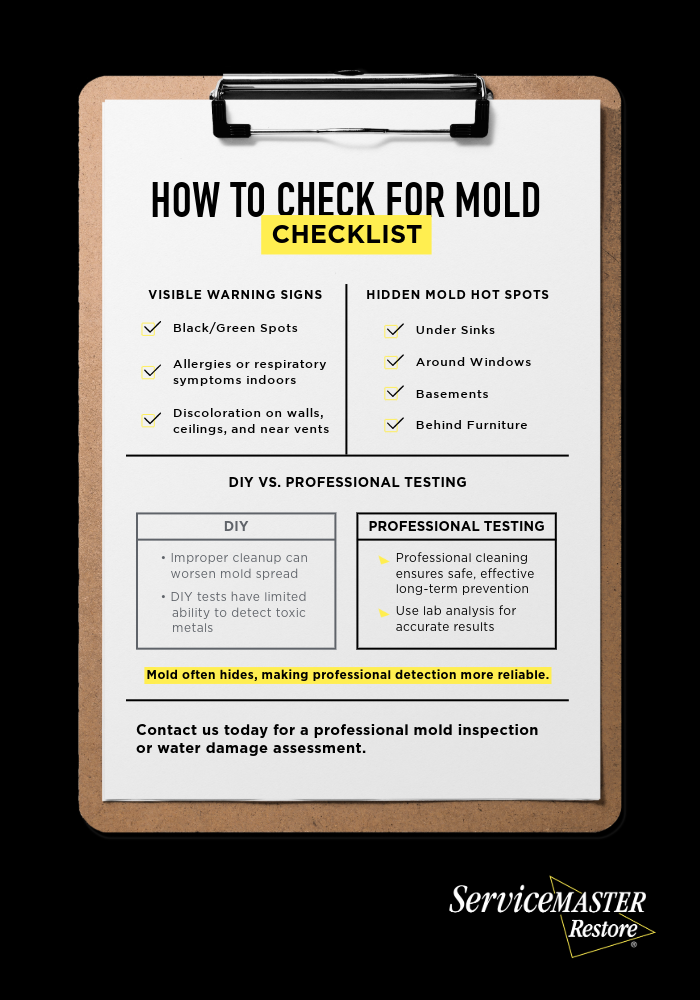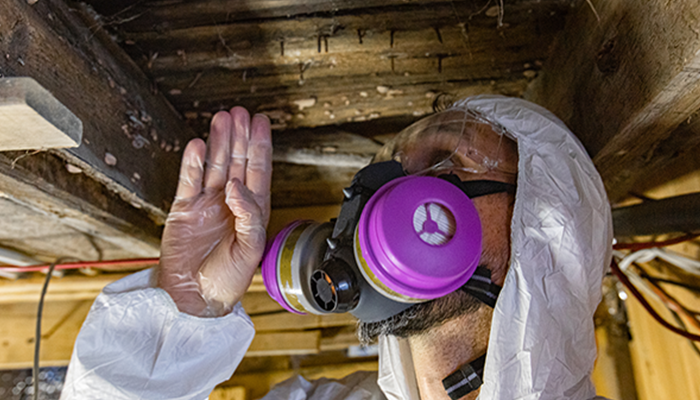
When your home has experienced water damage—whether from a burst pipe, flooding, or a leaky roof—the immediate concern is usually stopping the water and drying things out. But even after the water is gone, a hidden danger can remain - mold. Knowing how to check for mold in your home after water damage is essential for protecting your health, your home’s structure, and your peace of mind. Mold thrives in damp, dark spaces, making water-damaged areas a perfect breeding ground. Left unchecked, it doesn’t just degrade building materials—it can seriously affect indoor air quality and cause health problems, especially for vulnerable individuals like children, the elderly, or those with respiratory issues. Early detection is key. While some mold issues can be spotted visually, others require more advanced mold testing methods. In many cases, the safest and most effective course of action is calling in a professional mold remediation expert. Let’s explore the warning signs of mold, how to detect it, and when to seek expert help.
What Are the First Signs of Mold in Your House?
Mold doesn’t always announce itself loudly. In fact, it often begins silently, growing behind walls or under flooring long before you notice any visible signs. However, your home—and your body—may offer some early clues:
Common Signs That Mold Is Present:
A persistent, musty odor, especially in damp areas like basements or bathrooms
Black, green, or brown spots on walls, ceilings, or around air vents
Discoloration or bubbling paint, particularly near windows, under sinks, or in areas that recently had water exposure
Increased allergy symptoms or respiratory irritation that worsens indoors
Unexplained fatigue, congestion, or headaches that align with time spent in specific rooms
Pay close attention to common mold hotspots - behind furniture pushed against exterior walls, under carpets, in crawlspaces, or anywhere humidity lingers. If these signs appear after a water incident, mold could already be spreading.
How Can I Test for Mold in My House?
If you're wondering how to check for mold, the first step is a thorough visual inspection. But mold doesn’t always grow where it’s easy to see. You can purchase mold test kits at home improvement stores. These typically include petri dishes or swabs that collect mold spores from surfaces or the air. However, results may take days, and they often don’t identify types of molds or the exact concentration.
When to Consider a Professional Assessment
While DIY kits can provide basic information, they can miss mold hidden in walls, insulation, or HVAC systems. Professional mold remediators use specialized equipment—such as infrared cameras, moisture meters, and air sampling tools—to detect mold more accurately. Professionals can also differentiate between harmless surface mold and toxic molds that require urgent remediation. A visual inspection alone may not be enough, especially if your home has poor ventilation or recent water damage. If your gut tells you something’s off, it’s worth scheduling a professional evaluation.
Can You Test for Mold in the Air?
Absolutely. Indoor air quality testing is one of the most effective ways to detect hidden mold—especially in homes with air conditioning or central HVAC systems. When mold grows, it releases microscopic spores into the air. If your home has suffered water damage, those spores may linger long after the surfaces are dry. Air tests measure the concentration of mold spores and can pinpoint if indoor air is contributing to health symptoms like coughing or sinus issues.
Air Testing vs. Surface Sampling:
Air tests are best when no visible mold is present, but health symptoms persist
Surface tests work well when discoloration or mold spots are visible on walls or furniture
A combination of both offers the most comprehensive results
If your air feels damp or smells musty, an indoor air quality test can confirm whether spores are circulating through your vents, putting your entire household at risk.

How to Tell If Mold Is in Walls
One of the trickiest places for mold to grow is behind walls—where it remains hidden but dangerous. After water damage, even a small leak inside the wall cavity can allow mold to flourish. Warning Signs of Mold in Walls:
Peeling or bubbling paint
Staining or yellowing drywall
A damp or earthy odor near baseboards or outlets
Warping or softening of the wall surface
Professional mold inspectors use non-invasive tools like thermal imaging and moisture meters to locate mold behind surfaces. If you suspect mold but can’t see it, don’t cut into walls yourself. Disturbing mold can release spores into your home’s air.
How Can I Test for Black Mold in My House? Many homeowners ask how to check for black mold, which is often associated with toxic mold exposure. But not all dark-colored mold is harmful, and not all harmful mold is black. Stachybotrys chartarum, commonly referred to as “black mold,” grows in consistently wet areas like drywall soaked from flooding or slow leaks. DIY Test Kit Limitations:
While test kits might detect the presence of mold, they usually can’t confirm whether it’s toxic. Accurate identification requires professional lab analysis, which tests samples for spore type and mycotoxins. If you believe toxic mold is in your home—especially after water damage—schedule a professional inspection to ensure safe identification and removal.
What Are the Symptoms of Black Mold Exposure in a House?
Mold exposure affects people differently, but black mold exposure can produce a range of symptoms that should never be ignored.
Common Symptoms Include:
Chronic coughing, sneezing, or sinus congestion
Persistent headaches or fatigue
Skin irritation or watery eyes
Asthma flare-ups or other respiratory issues
Symptoms often worsen in specific areas of the house and may intensify over time. Those with allergies, asthma, or compromised immune systems are especially susceptible. Children and seniors are also more at risk of complications from prolonged exposure to mold spores. If these symptoms coincide with recent water damage or a musty indoor smell, mold could be the cause.
Can Black Mold Grow in Plumbing Pipes?
Yes—plumbing pipes, especially those in dark, moist spaces, can create ideal environments for mold growth. Though the inside of pipes might not be visible, leaky or sweating pipes can promote mold on nearby surfaces. Mold-Prone Plumbing Areas:
Under sinks and around faucet bases
Inside bathroom vanities or kitchen cabinets
Behind walls near plumbing lines
Around HVAC drain pans and condensate lines
If you notice recurring leaks or high humidity in these areas, take action immediately. Fixing leaks and drying wet materials quickly is the best defense against a future mold problem.

When to Call a Professional Mold Remediator
While small mold spots can sometimes be cleaned with household products, large or hidden infestations require professional intervention. Why Choose a Professional:
Specialized tools like air scrubbers, containment barriers, and moisture meters
Safe mold removal that prevents spores from spreading
Full assessment of water damage and prevention strategies
Attempting mold cleanup without proper training can make the issue worse. Professionals ensure that remediation is thorough, safe, and effective, eliminating not only the mold but the conditions that caused it.
How to Prevent Mold Growth After Water Damage
Prevention is always better than remediation, especially when it comes to mold. After your home has suffered water damage, acting quickly is crucial to minimize the risk of mold growth. Start by using fans and dehumidifiers to accelerate the drying process, particularly in areas that tend to retain moisture. Proper ventilation is equally important - pay close attention to spaces like bathrooms and kitchens, where humidity levels often run high. If any drywall or insulation has been soaked, it should be removed and replaced promptly, as these materials can harbor moisture long after surfaces appear dry. It’s also essential to address the source of the water damage, whether it’s a plumbing leak, roof issue, or faulty appliance, to prevent recurrence. In the weeks and months following, regular HVAC inspections can help identify potential humidity problems, and maintaining low indoor humidity levels will go a long way in discouraging mold growth. Remember, moisture control is the foundation of effective mold prevention. Just because the water is gone doesn’t mean you’re in the clear, mold can begin developing in as little as 24 to 48 hours.
Don’t Wait Until Mold Is a Bigger Problem
Understanding how to check for mold in your house after water damage isn’t just about protecting your property—it’s about safeguarding your health and your family’s well-being. Look out for early signs like odors, staining, and unexplained health symptoms. Know when DIY methods fall short and when to bring in professionals who can provide comprehensive mold testing, safe removal, and long-term prevention. At ServiceMaster Restore, we’re here to help you restore your home and peace of mind. Contact us today to schedule a professional mold inspection or water damage assessment.

